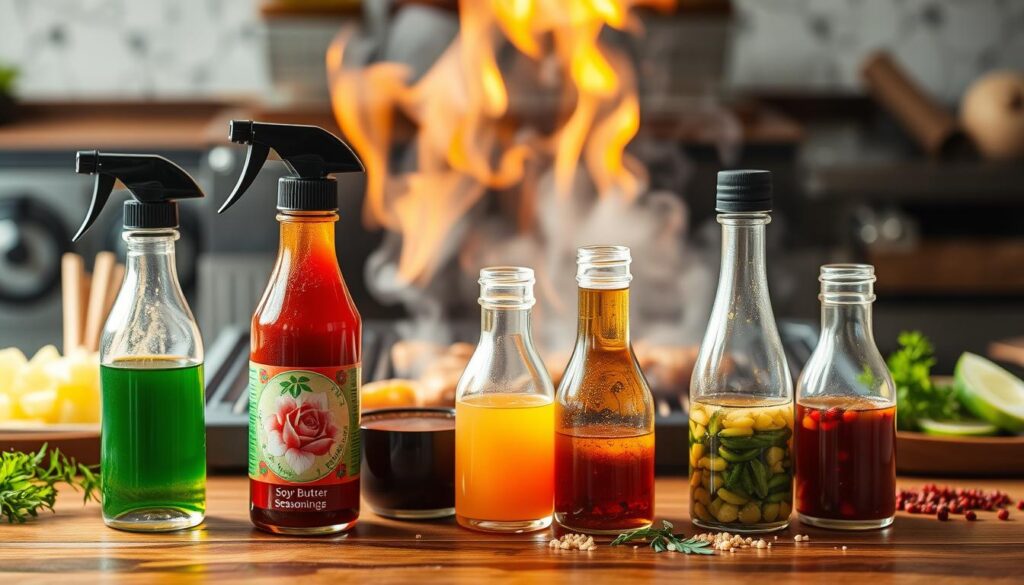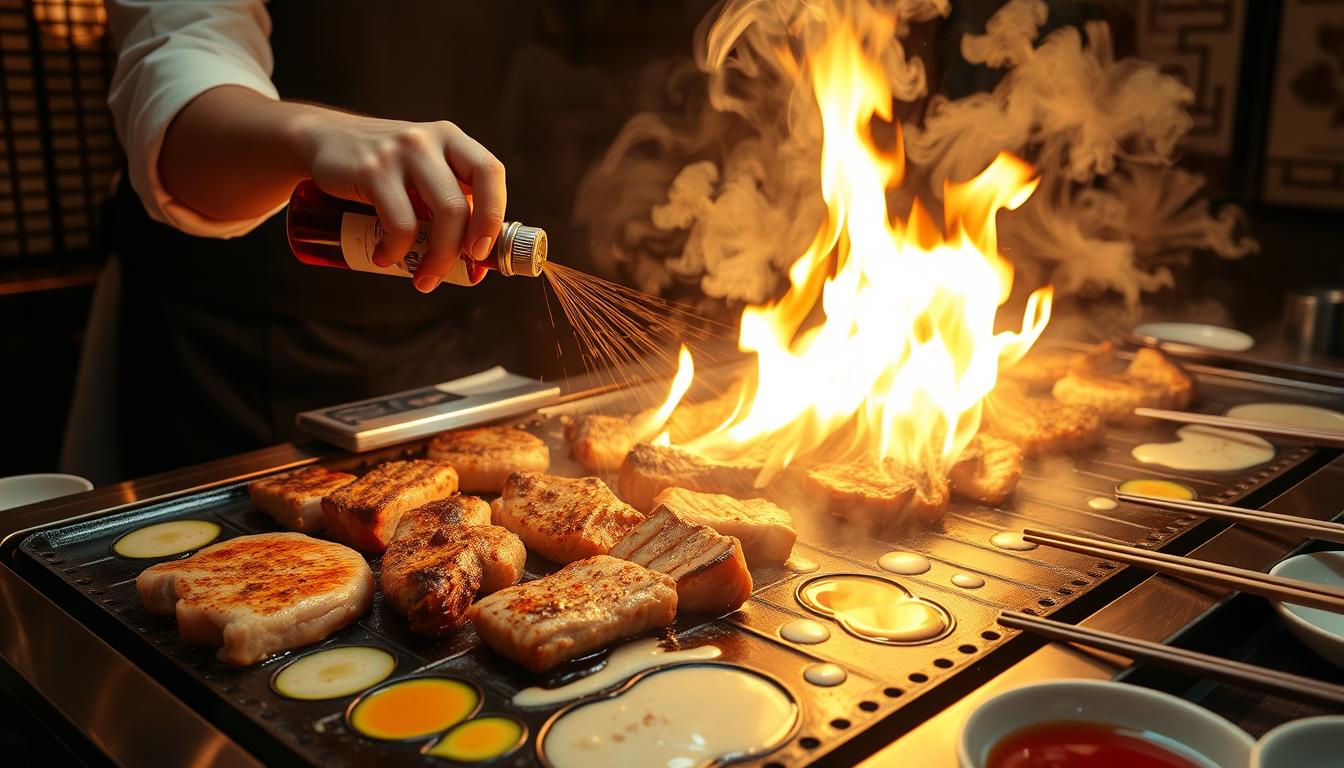Hibachi cooking turns simple meals into amazing shows. Skilled hibachi chefs make magic happen right before your eyes. They use special techniques that go beyond just Japanese food. When you see a hibachi chef work, you’ll notice they squirt unique flavors onto the food.
Hibachi chefs squirt different liquids onto the griddle, like sake, soy sauce, and special butter mixes. These liquids are key to making proteins and veggies taste great. The way they squirt and the timing make your meal unforgettable.
Hibachi cooking is more than just cooking. It’s a show that entertains while serving delicious food. From using alcohol flames to adding sauces, these chefs make every bite a sensory delight.
Key Takeaways
- Hibachi chefs use specialized squeeze bottles for flavor enhancement
- Liquid seasonings include sake, soy sauce, and butter mixtures
- Cooking is both a culinary and performance art
- Each squirt and technique adds unique flavor to the dish
- Hibachi cooking combines entertainment with exceptional cuisine
Understanding the Art of Hibachi Cooking
Hibachi cooking is a special way of cooking that mixes great food with fun shows. It comes from Japanese traditions and has grown into a big hit in Japanese steakhouses in the U.S.
Traditional vs Modern Hibachi Techniques
Hibachi cooking has changed a lot over time. It started in the Heian period (794-1185 AD). Back then, it was done with charcoal grills. Now, it’s a fun show in teppanyaki restaurants.
- Traditional hibachi uses open-grate charcoal grills
- Teppanyaki employs flat solid iron griddles
- Charcoal grills can reach temperatures up to 1200°C
The Role of Performance in Hibachi Cooking
Hibachi chefs are more than just cooks. They are entertainers who make cooking a show. They spend years learning how to cook and do tricks.
“75% of diners at teppanyaki restaurants enjoy the interactive cooking performance as a significant part of their experience.”
Essential Hibachi Kitchen Equipment
To make hibachi cooking at home, you need the right tools. Knowing what equipment to use is key.
| Equipment | Description |
|---|---|
| Teppanyaki Griddle | Minimum 24 inches for family cooking |
| Heat Source | Propane or charcoal |
| Cooking Utensils | Specialized spatulas and tongs |
Whether you’re eating out or cooking at home, hibachi is a mix of skill and show. It’s loved by food lovers all over the country.
Common Ingredients Hibachi Chefs Use for Flavoring
Hibachi cooking turns simple ingredients into amazing dishes. The secret is in the hibachi ingredients that make deep umami flavors. These flavors are special to Japanese seasonings.
Professional hibachi chefs use a few key ingredients to make their dishes stand out:
- Sesame oil for nutty depth
- Soy sauce for rich saltiness
- Fresh garlic for intense aroma
- Ginger for bright, spicy notes
- Hoisin sauce for sweet complexity
Choosing the right protein is key in hibachi cooking. Chefs often cook:
- Shrimp tempura
- Teriyaki steak
- Hibachi chicken
- Fresh seafood like scallops
“The secret to great hibachi is balancing flavors and understanding each ingredient’s potential” – Master Hibachi Chef
Vegetables add to the dish, with favorites like bell peppers, zucchini, mushrooms, and green onions. Each veggie is picked for its ability to cook well at high heat. It keeps its taste and nutrients.
Learning about these basic hibachi ingredients can make your meals special. You can create dishes that excite your taste buds with real Japanese seasonings.
The Secret Behind Hibachi Sauces and Marinades
Discover the magic of hibachi cooking with its amazing flavor enhancers and Japanese marinades. Professional chefs turn simple proteins into amazing dishes. They use special sauce combinations that make food taste incredible.
Hibachi sauces are a mix of ingredients that make food taste great and tender. Chefs know that the right marinade can make any protein unforgettable.
Base Sauce Components
The key to great hibachi sauces includes:
- Soy sauce for deep umami flavor
- Fresh ginger for aromatic complexity
- Minced garlic for robust depth
- Mirin for subtle sweetness
- Sake to enhance overall taste profile
Specialty Marinades for Different Proteins
Each protein needs a special hibachi chicken marinade and steak seasoning. Seafood flavoring is all about precision. Chefs balance ingredients to match the delicate texture of seafood.
Creating Signature Flavor Combinations
“Great hibachi cooking is an art form that transforms simple ingredients into extraordinary experiences.” – Master Hibachi Chef
Hibachi flavor combinations come from expert techniques and new ingredient mixes. Chefs mix unique tastes by trying out different ingredients. This surprises and delights diners.
| Protein Type | Key Marinade Components | Flavor Profile |
|---|---|---|
| Chicken | Soy sauce, ginger, garlic | Savory, aromatic |
| Beef | Sake, mirin, sesame oil | Rich, complex |
| Seafood | Citrus, butter, light soy sauce | Delicate, bright |
Learning about these sauce techniques can make your home cooking better. You can make hibachi dishes as good as those in restaurants in your own kitchen.
Understanding Sake and Oil Combinations
Cooking with sake makes hibachi dishes special. It’s not just for drinking; it’s a flavor enhancer. Chefs use it to make dishes taste amazing.
Hibachi oil blends are key to great meals. Chefs pick oils that improve cooking and taste. The right oil changes how food cooks and tastes.
“Sake is not just a drink, but a sophisticated cooking ingredient that elevates every dish.” – Japanese Culinary Experts
Key Sake and Oil Combination Techniques
- Select high-quality sake with clean, crisp flavor profiles
- Experiment with different oil blends like sesame, vegetable, and peanut oils
- Match sake characteristics with specific protein types
- Use minimal quantities for maximum flavor impact
Optimal Oil and Sake Pairings
| Protein Type | Recommended Sake | Oil Blend |
|---|---|---|
| Beef | Junmai Sake | Sesame and Peanut Oil |
| Chicken | Ginjo Sake | Vegetable and Sesame Oil |
| Seafood | Daiginjo Sake | Light Olive and Sesame Oil |
Knowing how sake and oil work together lets you make top-notch hibachi dishes at home. It’s all about finding the right balance of flavors.
Hibachi Chefs’ Professional Techniques
Mastering hibachi cooking needs a lot of skill and precision. Professional chefs have years of training. They create memorable meals that mix cooking art with fun.
Precise Sauce Application Techniques
Applying hibachi sauce is an art that needs careful attention. Chefs use special squeeze bottles to spread flavors evenly. They focus on:
- Controlling sauce flow with wrist movements
- Maintaining consistent sauce temperature
- Creating visual patterns while seasoning
Temperature and Timing Mastery
Temperature is key in hibachi cooking. Chefs watch the grill heat closely for perfect results. They use:
- Preheating the griddle to optimal temperatures
- Understanding protein cooking times
- Balancing heat for different ingredients
Safety First in Hibachi Cooking
Safety is always a top priority in hibachi cooking. Chefs follow strict fire rules and kitchen protocols. Important safety steps include:
| Safety Aspect | Implementation |
|---|---|
| Fire Prevention | Keep fire extinguisher nearby |
| Equipment Handling | Use protective gear |
| Work Station Management | Maintain clean, organized area |
“Precision and safety are the cornerstones of exceptional hibachi cooking.” – Professional Hibachi Chef
With 90% of hibachi chefs cooking in front of an audience, mastering these skills is crucial. It makes for an unforgettable dining experience.
Essential Liquid Seasonings in Hibachi Cooking

Hibachi liquid seasonings are the secret to amazing meals. They turn simple dishes into unforgettable culinary experiences. These seasonings are key to the unique taste that makes hibachi cooking so special.
The most common hibachi liquid seasonings include:
- Soy sauce (shoyu): Referred to as “Japanese Coca-Cola” by chefs
- Mirin: A sweet rice wine
- Sake: Traditional Japanese rice wine
- Sesame oil
Mixing these seasonings is an art in hibachi cooking. Chefs blend them to create complex flavors that excite your taste buds. The magic happens when these ingredients are skillfully mixed and applied during the cooking process.
“The difference between good and great hibachi cooking lies in the mastery of liquid seasonings” – Hibachi Chef
Each seasoning adds something special to the dish:
- Soy sauce adds depth and umami flavor
- Mirin provides sweetness
- Sake introduces a subtle alcohol note
- Sesame oil contributes a nutty aroma
Professional hibachi chefs know how to mix these seasonings. They balance them to create a harmonious taste experience. Their skill turns simple ingredients into memorable meals.
The Famous Onion Volcano Technique
Hibachi showmanship hits its peak with the onion volcano. It’s a show that mixes cooking skill with fire safety. This technique turns a simple onion into a dramatic display that wows diners at hibachi restaurants in the U.S.
Required Ingredients for Onion Volcano
To make the perfect onion volcano, you need certain ingredients:
- Large sweet onion (preferably Vidalia)
- High-proof alcohol (80-proof vodka recommended)
- Vegetable oil
- Flat metal spatula
Step-by-Step Process of Making an Onion Volcano
Learning to make an onion volcano takes precision and practice. Follow these steps carefully:
- Slice the onion into rings
- Stack the rings vertically, creating a tower
- Place carefully on a hot griddle
- Drizzle vegetable oil around the onion stack
- Carefully add a small amount of high-proof alcohol
- Ignite with a long lighter or cooking torch
Critical Onion Volcano Precautions
When doing this dramatic technique, safety is key. Here are important precautions:
| Safety Aspect | Recommended Action |
|---|---|
| Distance | Stand at least 3 feet away from the flame |
| Alcohol Proof | Use 80-proof vodka, avoid over 120-proof |
| Flame Control | Keep fire extinguisher nearby |
| Ventilation | Ensure proper kitchen ventilation |
“The onion volcano is not just a cooking technique, it’s a performance that requires skill, precision, and respect for fire safety.” – Professional Hibachi Chef
Remember, the key to a successful onion volcano is practice, safety, and a sense of culinary theater!
Popular Protein Preparations and Their Seasonings
Hibachi cooking brings a variety of protein options that excite our taste buds. You can enjoy everything from juicy hibachi chicken to perfectly seasoned steak. Each protein needs special care and seasoning techniques.
When choosing proteins, chefs usually pick from three main options:
- Chicken: A lean protein full of nutrients
- Steak: Known for its rich flavor and texture
- Seafood: Offers a range of marinades and cooking styles
Seasoning steak is key in hibachi cooking. Chefs suggest using unsalted butter to boost the meat’s natural taste. Choose top-quality cuts and season them well for the best results.
“The secret to perfect hibachi protein is balancing seasoning and cooking technique” – Professional Hibachi Chef
Seafood marinades turn simple proteins into amazing dishes. Popular marinades include:
- Soy sauce base
- Garlic and ginger infusions
- Sesame oil blends
Hibachi chicken has about 499 calories per serving, with 33g of protein. The cooking method uses quick, high heat to lock in flavors and keep nutrients.
For the best results, follow these protein cooking tips:
- Cook chicken for about 10 minutes
- Sauté vegetables for 5 minutes
- Use fresh, high-quality ingredients
Each protein needs special attention, from choosing the right seasoning to controlling cooking temperatures. Understanding these details is crucial for a great hibachi experience.
Specialized Tools for Liquid Application
Hibachi chefs use special sauce applicators to make their dishes unique. Hibachi squeeze bottles are key tools that make cooking special.

Knowing how to care for your hibachi tools can really boost your cooking skills. It’s not just about keeping things clean. It’s about keeping your tools in top shape.
Selecting the Right Squeeze Bottles
When picking out sauce applicators for hibachi, think about these important things:
- Material durability
- Nozzle precision
- Ease of cleaning
- Heat resistance
Maintenance and Cleaning Techniques
Proper care for your hibachi tools is more than just a quick rinse. Here are some expert cleaning tips:
- Take apart the squeeze bottles after each use
- Wash with hot, soapy water
- Sanitize with safe cleaning solutions
- Let them dry completely before putting them back together
| Bottle Type | Best For | Cleaning Difficulty |
|---|---|---|
| Plastic Squeeze Bottles | Oils and Light Sauces | Easy |
| Stainless Steel Bottles | High-Temperature Liquids | Moderate |
| Silicone Squeeze Bottles | Thick Marinades | Challenging |
“The right sauce applicator is a chef’s secret weapon” – Professional Hibachi Chef
Pro tip: Swap out your squeeze bottles every year to keep your kitchen clean and efficient.
The Role of Butter and Oil Mixtures
Hibachi cooking turns simple ingredients into amazing dishes. Chefs use special fats and oils to make each meal unique. They mix butter and oils to create flavors that make every dish special.
Professional hibachi chefs know choosing the right fats is key. They use oils that can handle high heat well. This ensures the food tastes great and feels right.
- Avocado oil: Preferred for its high smoke point of 520°F
- Grapeseed oil: Excellent for high-temperature cooking
- Canola oil: Versatile and budget-friendly option
Flavor-infused oils are crucial for hibachi dishes. Chefs make special butters to add richness to food. This makes proteins and veggies taste amazing.
| Oil Type | Smoke Point | Best Used For |
|---|---|---|
| Avocado Oil | 520°F | High-heat searing |
| Grapeseed Oil | 420°F | Stir-frying |
| Sesame Oil | 350°F | Finishing and flavoring |
Great hibachi cooking is all about knowing how fats work with heat and food. By getting good at mixing butters and oils, you can make any meal unforgettable.
“The secret is in the sizzle and the flavor-packed oils” – Hibachi Master Chef
Creating Signature Flavor Combinations
Making unique taste combinations is an art for hibachi chefs. It starts with knowing how ingredients work together. Chefs create special sauces that make meals unforgettable.
Creating memorable hibachi flavors involves:
- Balancing sweet, salty, and umami taste profiles
- Experimenting with unexpected ingredient pairings
- Understanding regional flavor influences
- Using high-quality, fresh ingredients
“The secret to great hibachi cooking is not just technique, but the ability to create flavors that tell a story.” – Professional Hibachi Chef
Start with a base of traditional Japanese seasonings like soy sauce and mirin. Add regional spices and herbs for depth and complexity. Think about how proteins like steak, chicken, or shrimp take on different flavors.
Creating unique flavors means being bold. Mix traditional Japanese ingredients with new ones like:
- Ginger and citrus zest
- Sake-infused marinades
- Toasted sesame oil
- Charred vegetable purees
For chefs, making signature flavors is about passion, creativity, and knowing how tastes come together. It’s what makes a meal memorable.
Conclusion
Your journey into hibachi cooking shows it’s more than just cooking. It’s a fun, flavorful adventure that draws people in. The Japanese restaurant industry made $22 billion in 2022, showing hibachi’s big impact on American food.
Hibachi cooking is a show that awakens your senses. It’s about the skill, the fire tricks, and the taste. It turns fresh ingredients into unforgettable meals that are good for you and fun to eat.
Want to try hibachi cooking at home or find the real deal in restaurants? Learning these techniques opens up a world of food adventures. It’s great for eating mindfully and controlling portions, making it a healthy choice.
Hibachi is growing and exciting food lovers everywhere. You can now dive into this cooking style that mixes tradition, showmanship, and amazing flavors. The skills you’ve learned are your ticket to a more engaging cooking and dining experience.
FAQ
What exactly do hibachi chefs squirt on food during cooking?
Hibachi chefs squirt on food a mix of soy sauce, sake, oils, butter, and special sauces. They use squeeze bottles to add flavor, make food look good, and keep it moist. This is all done on a hot griddle.
Is hibachi cooking the same as traditional Japanese cooking?
No, what Americans call hibachi is more like teppanyaki. Real hibachi is a small heating device. But today, hibachi restaurants use big griddles for cooking and shows.
What makes hibachi cooking unique?
Hibachi cooking is special because it’s interactive and fun. Chefs cook food and entertain guests with cool tricks like onion volcanoes and tossing shrimp. They also add sauces in a way that looks great.
What are the most common proteins used in hibachi cooking?
The most popular proteins are chicken, beef, shrimp, and seafood. Each is marinated and seasoned to bring out its flavor. This makes the food taste great with the high-heat cooking.
Are there specific safety concerns with hibachi cooking?
Yes, hibachi cooking is hot and uses open flames and alcohol. It’s important to have good air flow, handle oils safely, and keep a safe distance. This is true for chefs and home cooks.
What key seasonings are essential in hibachi cooking?
Key seasonings include soy sauce, mirin, sake, garlic, ginger, and oil blends. These give hibachi its unique taste, making it so tasty and special.
Can I recreate hibachi cooking at home?
Yes, you can try hibachi cooking at home. Use a flat griddle, good seasonings, and careful technique. Get quality ingredients, learn to manage heat, and be safe to make it like a pro at home.
What tools do hibachi chefs use for liquid applications?
Hibachi chefs use special squeeze bottles for sauce and oil. These bottles have different nozzles for even flavor and to make food look good. They help with both taste and presentation.

